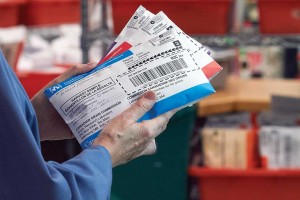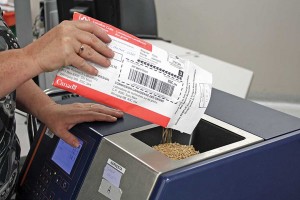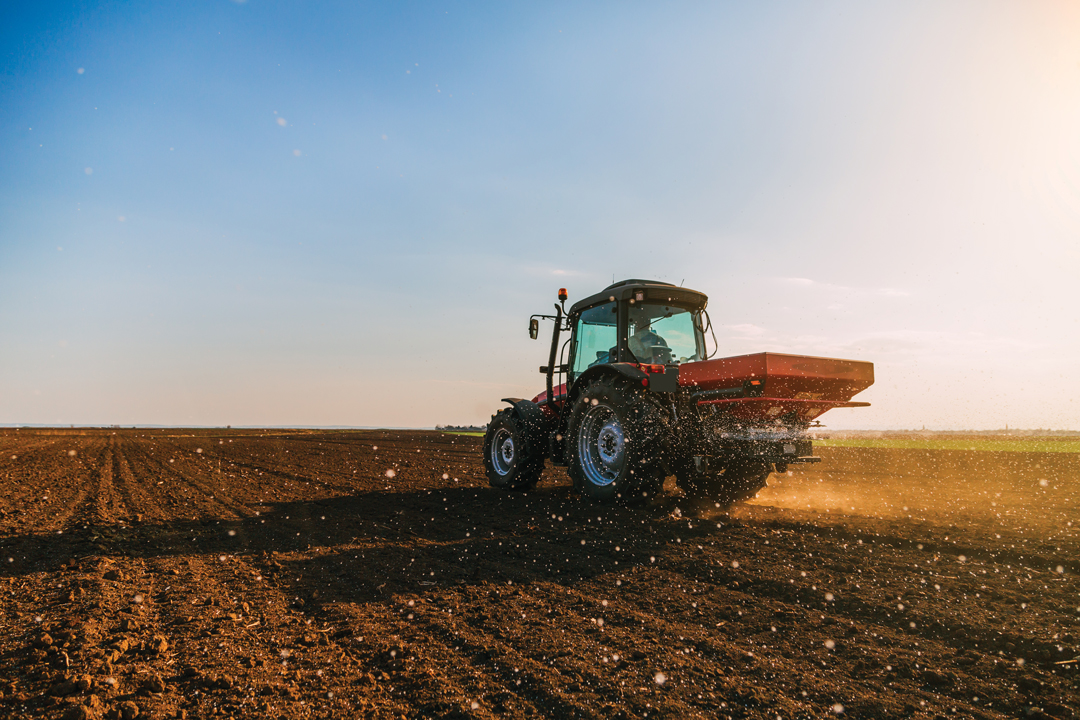SUBJECT TO SAMPLE
SELLING THE CANADIAN HARVEST WITH CROSS-COUNTRY COLLABORATION
BY SARAH WEIGUM
Those pails in bin doors across the prairies hold a lot of power. A single harvest sample can help an individual farmer negotiate price and delivery for his grain, but gather enough of those samples and the impact goes far beyond the farm gate or country elevator.
The Harvest Sample Program (HSP) run by the Canadian Grain Commission (CGC) and the Harvest Assessment Program operated by the Canadian International Grains Institute (Cigi) are paid for in part by farmers through fees and check-off dollars. In turn, these initiatives give farmers an objective assessment of their product, help market Canadian crops worldwide and can even nudge grading factors.
If you’ve ever questioned the grade your grain received at the local elevator, then consider the Harvest Sample Program (HSP) a second opinion. Producers can submit samples of grains and oilseeds to this voluntary program and receive an unofficial CGC grade, a breakdown of degrading factors, and a quality analysis that includes protein content of cereals and pulses, and oil and protein content of canola, flax, mustard and soybeans. This third-party assessment may provide producers with leverage when selling their grain.
Linda Schmidt grows wheat, barley, peas and canola near Manning, AB. With much of the grain from her farm being sold by producer car, it is important for her to know the grade and quality to prevent disputes with the buyer.
“We like to know as we’re combining along what grades we’ve got so we can price grain,” said Schmidt.
The deadline for submitting samples this year is Nov. 1. The sooner samples are submitted, however, the sooner farmers can receive their results—whether by phone, email or visiting the CGC’s booth at fall farm shows like Agri-Trade in Red Deer.
Schmidt appreciates the simplicity of the process.
“They send you everything you need,” she said, referring to the HSP package. “Postage is paid. You’re sampling anyway so you might as well use it.” While there are no additional costs for producers to use the HSP, farmers do pay an average CGC fee of $1.82 per metric tonne for grain shipped to Canadian ports.
According to Twylla McKendry, the CGC’s program manager for analytical services, the CGC sent out more than 26,000 sample packages in 2013 and had about 10,000 of them returned in the fall. While each program participant is limited to eight sample bags, there are no restrictions on the types of grains or oilseeds submitted. Whether it’s a variety of crops or eight different lots of hard red spring wheat represented in the samples, it is important that each bag is labelled with the class and variety name, the growing region, and the producer’s own identifier such as bin number or land location.
It only takes a couple minutes for inspectors and technicians at the CGC lab to grade and analyze a sample, but that’s just the beginning of the process for McKendry and her staff. They combine individual samples of similar grade from 10 growing regions to give buyers an idea of the average protein and quality in a specific area of the Prairies.
Composite samples of wheat of the same grade and protein are milled and baked to give further technical information on the performance of wheat in the form of flour, dough, bread and noodles. Pulses and oilseeds are also tested for specific quality parameters. Because samples are identified by variety, the CGC can also compare quality and performance by variety.
The samples help the CGC ensure that its grading factors reflect the current science and reality of grain conditions. Research on the effect of mycotoxins recently prompted a change to the ergot tolerance for most classes of wheat in Western Canada from 0.01 or 0.02 per cent to 0.04 per cent, meaning more grain can be delivered into higher classes while still maintaining food safety.
“We research the effect that grading factors have on quality, and the data generated provides us with the science to revise the grading factor tolerances to benefit producers,” said McKendry. She explained that the CGC is also researching a way to precisely determine chlorophyll content (green seed count). “Right now, the seed has to be crushed. We’re looking at ways to do that with an instrument so it’s not as subjective.”
As harvest rolls on across the Prairies and the CGC starts to amass samples directly from producers, Cigi also receives representative samples of each class and grade of wheat from grain handling companies.
Analyzing the wheat crop is a top priority in the fall. By November, Cigi staff, CGC staff and farmers depart for Asia, Europe, South America and Africa to talk to major buyers about the attributes of the year’s wheat crop.
Since each importing country generally buys wheat from a specific region of Canada, Cigi groups samples by region and soil type. A grain analysis looks at factors like bushel and thousand-kernel weight, protein, moisture and degrading factors. Cigi staff then mill the wheat to assess flour yield. The flour is further processed into bread and noodles. Over 20 tests measure factors that matter to millers and bakers — from flour colour and spaghetti strength to bread baking time and the distance a ball of dough can be stretched before it breaks.
Rex Newkirk, vice-president of research and innovation at Cigi, explained the two-fold objective of Cigi’s harvest assessment.
“One of the objectives is to provide analysis back to specific grain companies on the samples from their regions. This gives information they can use in their buying decisions,” said Newkirk. The other objective is to give international buyers the “best representation, from a commercial perspective, of what’s coming out of each region.”
As well as taking information to buyers, Cigi conveys feedback from buyers to Canadian industry participants. For example, if gluten strength is inconsistent, staff at the Cigi lab will try to determine if the cause is varietal or environmental. If buyers want a different class of wheat, Cigi will request Canadian grain handlers include those samples in the harvest assessment program.
For most of its 40-year history as the technical arm of the Canadian grain industry, Cigi worked on behalf of the Canadian Wheat Board and was “kind of
lost in the mix,” said Newkirk. As the CWB monopoly ended and new wheat associations were developing, Cigi recognized a gap in the international marketing of Canadian wheat and took the lead on trade missions.
“We had to take a very proactive role to make sure nothing fell through the cracks as the new organizations were forming,” said Newkirk.
He sees the provincial wheat commissions and Cereals Canada taking a larger role in trade missions promoting Canadian wheat in the future, but explained that marketing the Canadian crop won’t likely be the sole purview of private grain handlers.
“When buyers are buying, they look at a number of suppliers. Grain companies can’t invest a lot of money and time in an area where their competition might get the sale,” said Newkirk. He added that trade missions representing the entire Canadian crop are more efficient, bringing all the major buyers to one seminar in each region.
Keith Bruch, vice-president of operations at Paterson GlobalFoods, credits Cigi for building strong relationships with international grain buyers.
“Cigi, being an impartial entity commercially speaking, can really play a role in increasing the Canadian brand vis-a-vis other origins,” explained Bruch. “They’re well known, well respected, and really the only general source of information on the Canadian crop.”
As Bruch points out, U.S. Wheat Associates, with 17 global offices, provides stiff competition for the Canadian crop.
“Canada needs to do at least as good a job or better to make sure that Canadian varieties have their place in the market.”
The co-ordinated effort to market Canadian grains and oilseeds is a top priority for JoAnne Buth, Cigi’s new CEO.
“There needs to be really strong collaboration throughout the industry and that needs to start with the producers and go all the way to the international buyers,” explained Buth, who came to Cigi from the Canadian Senate where she represented Manitoba for two-and-a-half years. Before serving in the Senate, Buth had a varied career in agriculture, working for the Canola Council of Canada (vice-president and president), Manitoba Agriculture, Agriculture and Agri- Food Canada, and DowElanco (now Dow AgroSciences). Throughout her professional life, Buth said farmers have been her top priority.
“When I was VP of crop production at the Canola Council, I always said, ‘it has to go back to the grower,’ because they’re making the choice of what to grow,” said Buth. “I think it’s important that Cigi continues to focus on growers and bringing the value of the Canadian crop to growers.”
Buth believes that by working with other organizations that promote agriculture to Canadians, Cigi can help showcase the value of Canadian crops not only to buyers around the world, but to fellow Canadians.
“Canadians need to understand how important agriculture is to the economy,” said Buth. “I think there’s a role for Cigi to provide good information on where Canadian products go in the world.”
For every tonne of wheat sold to a CGC-licensed company, $0.15 goes to Cigi. Buth encourages farmers to attend Cigi’s Combine to Customer programs to see how their check-off funds are used. This three-day seminar runs several times each winter and allows farmers to see Cigi in action and learn about what matters to international buyers.








Comments